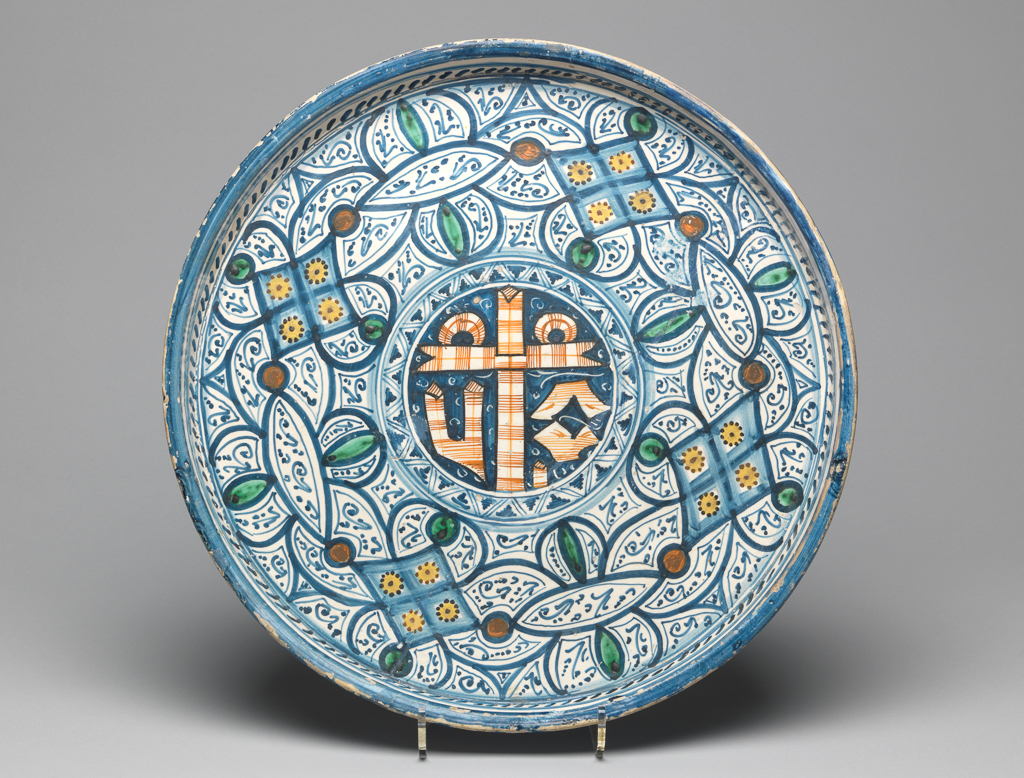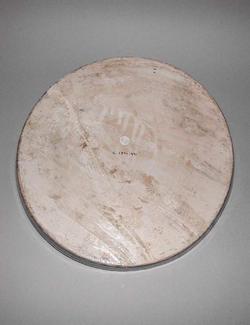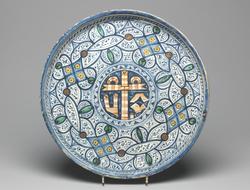Current Location: In storage
Maker(s)
Maker:
Unidentified Montelupo potter
Entities
Categories
Description
Renaissance maiolica tray or wall panel, painted in polychrome with a debased form of the Sacred Monogram, surrounded by lozenges, zig-zags, strokes, stems and leaves.
Earthenware, tin-glazed on the front and outside wall and dribbled across the unglazed base. Painted in blue, green, yellow, orange-red, and black. Circular with shallow vertical sides and flat base which has warped in firing.
The central medallion contains a debased form of the Sacred Monogram, outlined in orange and reserved in a blue ground, surrounded by a blue zig-zag border. The rest of the base is decorated with four lozenges with a spot at each point linking them to almond, oval and segmental shapes filled with small strokes and stylised stems and leaves. Round the sides there are short oblique strokes between blue bands and a wide blue band on the rim. The exterior is decorated with three blue horizontal bands.
Notes
History note: H.S. Reitlinger (d.1950); the Reitlinger Trust, Maidenhead, from which transferred in 1991
Legal notes
H.S. Reitlinger Bequest, 1950.
Measurements and weight
Diameter: 36.2 cm
Height: 4 cm
Acquisition and important dates
Method of acquisition: Bequeathed
(1991-04-29)
by
Reitlinger, Henry Scipio
Dating
16th Century, second half
Renaissance
Circa
1550
CE
-
1600
CE
Note
Label text from the exhibition ‘Madonnas and Miracles: The Holy Home in Renaissance Italy’, on display at The Fitzwilliam Museum from 7 March until 4 June 2017: IHS (sometimes YHS) is an abbreviated form of the Greek word for Jesus (). In Renaissance Italy, devotion to the Name of Jesus increased, in part encouraged by the Franciscan preacher Bernardino of Siena, who held up a painted panel with the letters ‘YHS’ during his sermons. The sacred monogram ‘IHS’ was often to be found in the Renaissance home, inscribed above doorways, painted onto plates and dishes and used as a decorative theme on furniture or jewellery.
Components of the work
Decoration
composed of
high-temperature colours
( blue, green, yellow, orange-red, and black)
Materials used in production
base unglazed
Tin-glaze
Earthenware
Techniques used in production
Tin-glazing
: Earthenware, tin-glazed on the front and outside wall and dribbled across the unglazed base. Painted in blue, green, yellow, orange-red, and black.
Inscription or legends present
Inscription present: debased form of the sacred trigram, ihs
- Text: ihs
- Location: In centre of front
- Method of creation: Painted in dull orange
- Type: Inscription
Inscription present: circular with serrated edge
- Text: 597/a
- Method of creation: Inscribed in pencil
- Type: Label
References and bibliographic entries
Related exhibitions
Identification numbers
Accession number: C.189-1991
Primary reference Number: 48470
Packing number: EURCER 352
Stable URI
Audit data
Created: Saturday 6 August 2011
Updated: Tuesday 30 April 2024
Last processed: Wednesday 14 May 2025
Associated departments & institutions
Owner or interested party:
The Fitzwilliam Museum
Associated department:
Applied Arts

 IIIF Manifest
IIIF Manifest






